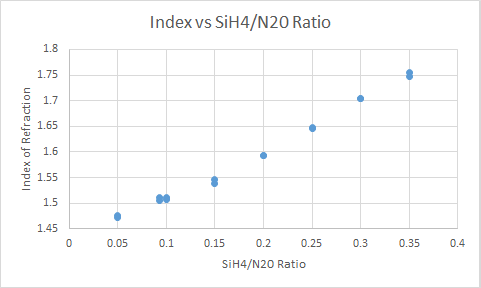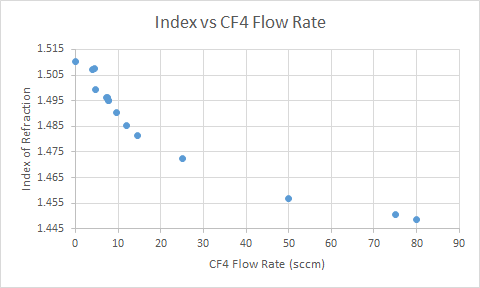Navigation Menu 
[expand all...]
[COLLAPSE ALL...]

|
Expand All
Compress All
- General Description
- The Plasma Enhanced Chemical Vapor Deposition (PECVD) 3 machine is used to deposit thin dielectric films. It combines up to four gases at pressures between 0.01 and 2 Torr and uses RF and LF sources of up to 600 Watts (total power 650 W) to ionize the resultant gas mixture, causing film deposition on a heated substrate (250-300°C). Films that can be deposited with the system include: SiO2, SiOxNy, and SiN. Currently, PECVD3 is only used to deposit SiO2. Dr. Hawkins must approve any use of PECVD3.
- PECVD allows us to deposit good-quality films at low temperatures (250-300°C). However, these films are inferior to thermal CVD films in several ways:
- PECVD oxide is amorphous and non-stoichiometric. This means that instead of growing stoichiometric SiO2, what really is deposited is SiOxHy, with the hydrogen coming from the precursor gas silane. Because of this, the film has lower density than thermally grown SiO2.
- PECVD oxide is not as good an electrical insulator as thermal oxide.
- PECVD oxide is physically rougher than some other oxides.
- PECVD oxide can be deposited with a refractive index from 1.45-1.47.
- Operating Instructions
- Starting up the necessary equipment
- NOTE: If the computer does not boot past the blue HP screen, unplug the keyboard, reboot, and plug it back in after the computer boots up.
- The PECVD3 needs power to operate. Flip the large lever on the wall adjacent to the machine to the on position to supply power. The Power light on the machine should light up.
- Next, open the front of the machine by twisting the black knob counter clockwise and press the green button to turn the machine on. The System light on the machine should light up.
- Open the software on the computer's desktop called PC2000. It is a pink icon. Once open, put in the given username and password received during training and press enter.
- Accept all the warnings that pop up and go into Service mode from the System menu and click on the pump icon near the bottom right to send power to the pump. Exit service mode.
- Go into the pump room and turn on the pump with the controller by pressing Control, Enter to take Control, Pump, Enter to turn on pump. You should hear the pump start. Ignore any Overrange errors, but monitor the SSPurge pressure. Once the pump is on it should stay between 4-6 PSI (you can view the current pressure by going to Status and scrolling up with the arrows to see the SSPurge Pressure), and the 2 green lights in the front of the pump should be lit. Adjust the pressure if needed with the small knob below the green lights.
- Make sure the chiller next to the pump is on, is set to 30°C, and that water is flowing. To turn it on, flip the breaker, and push the on/off button. Normally, the chiller is always on.
- The process gases include 5% silane in helium (SiH4/He), nitrous oxide (N2O), and halocarbon cleaning gas (20% O2 in CF4). The tanks are located in the gas cabinet adjacent to the cleanroom. To turn on the 5% silane, touch the overhead monitor button, press the line, press enter. The CF4 and N2O are not run through the control panel of the gas cabinet. The CF4 must be turned on and off using the valve on top of the gas cylinders inside the cabinet.
- Depositing Oxide
- On the main software page, click on the System tab, choose Pumping. Click Stop, then Vent. Wait until timer has 15 seconds remaining then raise the chamber by pushing the two blue buttons.
- Insert the wafer, close the chamber, and then click Stop, followed by Evacuate to pump air out of the chamber.
- Click the Process tab and choose Recipe. Load the desired recipe. Click on each step to ensure the desired parameters. Then click Run. The recipe will run once all parameters are in tolerance.
- When the recipe is complete, a Yellow Alert will appear (the process will end automatically). Click Accept, then open the chamber by following step 1 above.
- Remove your wafer and wipe the chamber and shower head with an IPA sprayed clean room towel as necessary.
- Close the chamber by following step 2 above.
- Cleaning Chamber
- Make sure no one else is using the process gases on PECVD2 then turn off the gases and turn on the cleaning gas.
- Follow the same procedures above under Depositing Oxide, but choose the cleaning recipe instead at whatever temperature you were running the oxide at (ex. 250°C). Run for the same amount of time or more as you deposited oxide.
- Shutting down the PECVD3
- On the main software page, click the System tab, choose Service. Click Stop to close the pump valves, then click on the pump icon to cut power to the pump.
- Click the System tab again and choose Exit to exit the software.
- Turn off the monitor, open the machine door and press the red button to turn off the machine, and flip the lever to the off position.
- Make sure no one else is using the process gases on PECVD2 then turn off the process gases.
- Machine Characterization
- Chamber Characterization
- The index of refraction, film stress, and deposition rate were measured when varying the ratio of SiH4 and N20 and are found on the graphs below. The base recipe was 16 watts, 164 sccm Silane/Argon, 88 sccm N20, 1900 mT, and 250 C. This is a SiH4/N20 ratio of 0.093.
  
- CF4 Characterization
- The index of refraction, film stress, and deposition rate were measured when varying the amount of CF4 added to a run and are found on the graphs below. The base recipe was 16 watts, 164 sccm Silane/Argon, 88 sccm N20, 1900 mT, and 250 C.
  

|
